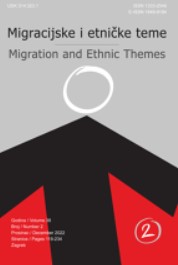Metodološka pitanja popisne etnostatistike u svetlu savremenih imigracionih trendova u Srbiji
The Methodological Issues of Census Ethnostatistics in the Light of Contemporary Migration Trends in Serbia
Author(s): Aleksandar KneževićSubject(s): Demography and human biology, Migration Studies, Ethnic Minorities Studies, Politics and Identity, Asylum, Refugees, Migration as Policy-fields
Published by: Institut za migracije i narodnosti
Keywords: census; ethnic identity; foreign citizens; ethnostatistical nomenclatures; Republic of Serbia;
Summary/Abstract: The results of previous demographic research according to the ethnic characteristics of the population clearly point to the need for caution when using data from official ethnostatistics. Censuses and vital statistics form a quantitative basis for calculating ethno-demographic indicators whose interpretations can directly affect the creation of public policies aimed at the legal, political, economic and general social position, not only of members of minority ethnic groups, but also of the entire population. Although census ethnostatistics has been suspended in a large number of developed countries, there is a noticeable increase in interest in quantitative research on population demographic characteristics relating to ethnicity. On the other hand, in countries that already have developed census ethnostatistics, there is reasonable doubt about the quality of the data, which leads to a review of the census methodology, starting with definitions and statistical categorisations, and ending with the methods of data collection and publication. So far, the results of population surveys according to ethnic characteristics provide enough space for various interpretations of the data because censuses often represent much more than a statistical record of social reality. This is especially noticeable in statistical categorisations based on ethnic characteristics, assigning censuses a significant role in constructing this reality that additionally reinforces the existing population divides. The collection of statistical data on the ethnic characteristics of the population of Serbia has a long tradition, primarily due to the historically inherited heterogeneous ethnic structure. In censuses during the first half of the 19th century, data on ethnic characteristics were collected only sporadically, but after Serbia had gained independence in 1878, ethnostatistics became one of the most important factors in political and overall social activity. Although a direct question about national (then ethnic) affiliation first appeared in the 1866 census, the opinion quickly prevailed that it was strongly influenced by the subjective understanding of ethnic identity, which was often equated with citizenship at that time. That is why language was given priority over ethno-national affiliation because, in addition to being of key importance for the creation of ethno-cultural and national identity, it also proved to be a statistically more objective indicator.
Journal: Migracijske i etničke teme
- Issue Year: 2022
- Issue No: 2
- Page Range: 125-148
- Page Count: 24
- Language: Serbian

